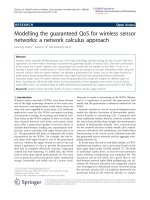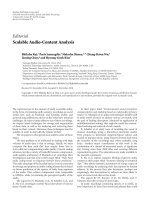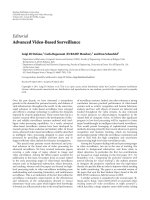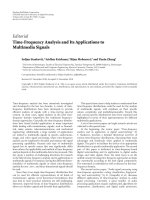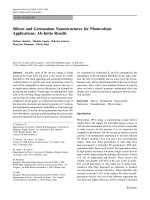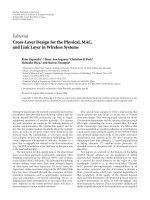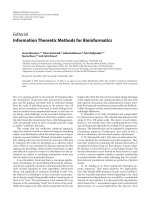Báo cáo hóa học: " Editorial CMOS RF Circuits for Wireless Applications" doc
Bạn đang xem bản rút gọn của tài liệu. Xem và tải ngay bản đầy đủ của tài liệu tại đây (668.84 KB, 2 trang )
Hindawi Publishing Corporation
EURASIP Journal on Wireless Communications and Networking
Volume 2006, Article ID 86753, Pages 1–2
DOI 10.1155/WCN/2006/86753
Editorial
CMOS RF Circuits for Wireless Applications
Kris Iniewski,
1
Mourad El-Gamal,
2
and Robert Bogdan Staszewski
3
1
Department of Electrical & Computer Engineering, University of Alberta, ECERF Building, Edmonton, AB, Canada T6G 2V4
2
Department of Electrical & Computer Engineering, McGill University, McConnell Engineering Building, Room 633,
3480 University Street, Montreal, PQ, Canada H3A-2A7
3
Dig ital RF Processor Group, Texas Instruments, Dallas, TX 75243, USA
Received 20 June 2006; Accepted 20 June 2006
Copyright © 2006 Kris Iniewski et al. This is an open access article distributed under the Creative Commons Attribution License,
which permits unrestricted use, distribution, and reproduction in any medium, provided the original work is properly cited.
Advanced concepts for w ireless communications present a
vision of technology that is embedded in our surround-
ings a nd practically invisible, but present whenever required.
From established radio techniques like GSM, 802.11, or Blue-
tooth to more emerging like ultra-wideband (UWB) or smart
dust moats, a common denominator for future progress is
the underlying CMOS technology. Although the use of deep-
submicron CMOS processes allows for an unprecedented de-
gree of scaling in digital circuitry, it complicates implementa-
tion and the integration of traditional RF circuits. The explo-
sive growth of standard cellular radios and radically different
new wireless applications makes it imperative to find archi-
tectural and circuit solutions to these design problems.
This special EURASIP issue contains carefully selected
12 papers that represent state-of-the-art CMOS designs for
wireless applications. The first group of three papers from
University of California at Berkeley, Philips Research, and
the University of Alberta discusses various system aspects in
the context of CMOS implementation. Cabric et al. propose
novel radio architectures that might be used at 60 GHz and
for cognitive radios. Leenaerts presents one of the first CMOS
circuit implementations of the ultra-wideband (UWB) tech-
nology. Howard et al. delineate conditions under which er-
ror control coding (ECC) is efficient from an energy point of
view in wireless sensor networks (WSNs).
While it is true that heterogeneous circuits and architec-
tures originally developed for their native technologies can-
not be effectively integrated “as is” into highly scaled CMOS
processes, one might ask the question whether those func-
tions can be ported into more CMOS-friendly architectures
to reap all the benefits of the digital design and flow. It is
not predestined that RF wireless frequency synthesizers be al-
ways charge-pump-based PLLs with VCOs, RF transmit up-
converters be I/Q modulators, receivers use only Gilbert cell
or passive continuous-time mixers. Performance of modern
CMOS transistors is nowadays good enough for multi-GHz
RF applications.
The following four papers from Texas Instruments, Car-
leton University, and Silicon Labs describe the RF CMOS cir-
cuit design challenges. Ho et al. present a key component of
RF direct processing—the RF sampling mixer. The circuit is
used in Bluetooth and GSM applications. Koh et al. propose
a novel sigma-delta ADC with embedded decimation and
gain control. The remaining two papers in that group address
challenges of phase-locked loop (PLL) design for RF applica-
tions. Rogers et al. provide a tutorial on phase noise model-
ing for fractional PLLs, while Maxim presents solutions for
effective power supply filtering and their effects on PLL per-
formance.
Low power has been always important for wireless com-
munications. With new developments in wireless sensor net-
works and wireless systems for medical applications, the
power dissipation is becoming the number one issue. Tra-
ditional wireless markets like cellular telephony or wireless
LANs demand low power as well. This calls for innovative
design methodologies at the circuit and component levels to
address this rigorous requirement.
The third group of papers from the University of British
Columbia (UBC), Carleton University, and the University of
Calgary addresses some of the circuit problems at the com-
ponent and technology levels. Chamseddine et al. propose
a new structure for an RF switch implemented in a system-
on-sapphire (SoS) technology. Danson et al. show how a
MEMS technology can be used to improve RF performance,
using an LNA and a power amplifier as examples. Sameni et
al. introduce a new model for VCO modeling, while Chan et
al. present a novel application for parameter conversion us-
ing a MOS varactor as a key device.
2 EURASIP Journal on Wireless Communications and Networking
Effective CMOS RF desig n would not be possible with-
out proper electronic design automation (EDA) tools. The
last paper of the special issue by Zhu et al. from Lakehead
University reviews some circuit simulation techniques used
for RF simulations.
The special issue would not be possible without the dedi-
cated efforts of many reviewers for which the editors are very
grateful. We hope that the collected research papers can help
in fulfilling a gap between the two communities of CMOS
circuit designers and experts in wireless communication the-
ories.
Kris Iniewski
Mourad El-Gamal
Robert Bogdan Staszewski
Kris Iniewski is an Associate Professor at
the Electrical Engineering and Computer
Engineering Department, University of Al-
berta. He is also a President of CMOS
Emerging Technologies, Inc., a consulting
company in Vancouver. His research inter-
ests are in advanced CMOS devices and
circuits for ultra-low-power wireless sys-
tems, medical imaging, and optical net-
works. From 1995 to 2003, he was with
PMC-Sierra and held various technical and management positions
in Research & Development and Strategic Marketing. Prior to join-
ing PMC-Sierra, from 1990 to 1994, he was an Assistant Professor
at the University of Toronto’s Electrical Engineering and Computer
Engineering Department. He has published over 80 research pa-
pers in international journals a nd conferences. He holds 18 inter-
national patents granted in USA, Canada, France, Germany, and
Japan. He is a frequent invited speaker and consults for multiple
organizations internationally. He received his Ph.D. degree in elec-
tronics (with honors) from the Warsaw University of Technology
(Warsaw, Poland) in 1988. Together with Carl McCrosky and Dan
Minoli he is an author of Data Networks-VLSI and Optical Fibre
(Wiley, 2006). He is also an editor of Emerging Wireless Technolo-
gies (CRC Press, 2006).
Mourad El-Gamal is an Associate Profes-
sor of electrical engineering at McGill Uni-
versity, Montreal, Canada, where he holds
the William Dawson Scholar Chair. He is
also the President of InfiniteChips, Inc., a
company that provides integrated circuit
solutions for a variety of markets. In 2002
he was the Director then VP Engineering
at MEMSCAP in France—a 165-employee
public company. He oversaw the business
and technical aspects in different sites around the world related to
RF-MEMS devices, RFICs, and millimeter-wave passive circuits. He
published over 60 technical papers, and one book chapter on low-
voltage 5-GHz RFIC front ends. Dr. El-Gamal served as a Guest Ed-
itor for the IEEE Journal of Solid-State Circuits, and is currently an
Associate Editor of the IEEE Transactions on Circuits and Systems.
He is on the Executive Committee of the IEEE Bipolar/BiCMOS
Circuits and Technology Meeting (BCTM), a Member of the
Emerging Technologies Committee of the IEEE Custom Integrated
Circuits Conference (CICC), and a Member of the Analog Signal
Processing Committee of the IEEE Circuits and Systems (CAS)
Society. Earlier, he worked for the French telecommunications
company ALCATEL, and for IBM. He regularly serves as consul-
tant for microelectronics companies. He holds one patent and has
three patents pending.
Robert Bogdan Staszewski received the
B.S.E.E. (summa cum laude), M.S.E.E., and
Ph.D. degrees from the University of Texas
at Dallas in 1991, 1992, and 2002, respec-
tively. From 1991 to 1995, he was with Al-
catel Network Systems in Richardson, Tex,
working on Sonnet cross-connect systems
for fiber optics communications. He joined
Texas Instruments in Dallas, Tex, in 1995
where he is currently a Distinguished Mem-
ber of Technical Staff. Between 1995 and 1999, he has been engaged
in advanced CMOS read channel development for hard disk drives.
In 1999 he costarted a Digital RF Processor (DRP
TM
) Group within
Texas Instruments with a mission to invent new digitally inten-
sive approaches to traditional RF functions for integrated radios in
deep-submicron CMOS processes. He currently leads the DRP sys-
tem and design development for transmitters and frequency syn-
thesizers. He has a uthored and coauthored 60 journal and confer-
ence publications and holds 25 issued and 35 pending US patents.
His research interests include deep-submicron CMOS architectures
and circuits for frequency synthesizers, transmitters, and receivers.
